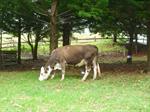House Cow

If a property is large enough, and the owners aim is self-sufficiency there will often be a strong impetus to incorporate a dairy cow into the property. This is possible on acreage; but not a good idea on a small property.
You should think very carefully about whether to keep a milking cow; and make sure you fully understand everything that is involved before making that decision.
The following things need to be considered:
- Space: The space that one cow might take up; could this space be occupied by many other types of animals; giving you a greater diversity of produce.
- Cows require regular milkings: If you want to keep getting milk, you need to keep milking regularly. You cannot take a break for a holiday, stopping milking for a while and then expect the milk to flow again when you want it.
- Surplus milk: One cow can produce a lot more milk than what one or two people might require. Though the surplus milk may be traded for other produce in the community.
- Environmental Impact: When a small property gains or loses a single large animal like a cow, it will potentially have a far greater impact upon the environmental balance of the system; than what a much smaller animal would.
Dairy cattle milk can be used to make a variety of food such as cheese, yoghurt, cream etc. If you do decide to have a dairy cow/s you would want to keep them in a zone closer to the house than beef cattle because you would be regularly bringing the cow in to milk(1-2 times a day).
Choosing your dairy breed
There are real differences among the dairy breeds in size, maturity, fat content of the milk and other important features. In selecting a breed, the farmer will do well to examine his farming enterprise with care to choose a breed that suits his requirements. The availability of both cows and bulls is an important consideration in this choice. For example, Jerseys are far more heat resistant than Holstein-Friesians and are also better foragers. Therefore, Jerseys are more suited to hotter areas and to more extensive dairying. Ayrshires are also said to be good foragers but are more sensitive to poor handling than are Holstein-Friesians or Jerseys.
Animals can usually adapt to a new environment, but this can be a lengthy process. Buying animals from an area with similar climatic conditions, preferably close to your locality, is a recommended practice.
The choice of a dairy breed usually depends on one or more of the following:
- The breeding stock available in the area and the cost of these animals;
- The adaptability of the selected breed to local conditions such as climate, feed and grazing conditions;
- The reproductive capacity of the breed and its ability to produce good quality milk; and
- Personal preference and past experience of the farmer.
Health
Small naturally managed properties are more likely to promote a healthier and happier cow than a large scale dairy production, due to the fact that the animals are not under as much production stress, there is usually less animals coming in and out of the herd meaning that diseases are less likely to be carried in, there are smaller numbers of animals so they can be individually monitored easily, and they are able to display all their natural grazing behaviours.
Mastitis is one of the most common health problems found in dairy cattle, it is an inflammation of the udder usually caused by bacteria invading the milk producing tissue. Look out for signs of swelling of the udder, redness, pain and loss of milk production.
Feeding
Lactation is a high energy metabolic activity. This means it is very important to provide quality nutrition to dairy cattle in order to maintain their body weight and support their milk production energy requirements.
Each cow will require approximately 1 acre of land to graze and approximately 1 acre set aside to harvest hay from, to feed to the cows when food is limited i.e. over winter.
Pasture management should be planned for in order to care for the sustainability of your pastures. Rotational grazing can be used to make sure livestock are not grazing the same pastures or overgrazing the pastures. Alternating between grazing and using it to harvest hay is the easier way to practice rotational grazing. It may also be beneficial to rotate species (i.e. sheep and cattle) as this minimises parasite spread, as many sheep parasites cannot infect cattle, this then breaks that parasite cycle as they have no viable hosts to live off.
Housing
Depending on your location you may be able to house the cow outside all year, however in some locations they may need to be housed in a barn for the winter months. While housed in a barn they will need feeding with hay you would have harvested and stored.
Pastures where cows are housed should contain shelter i.e. tree or shed, and a source of fresh water i.e. trough or dam etc.
To learn more about managing a cow -study either our Dairy Cattle Course; or our Animals in Permaculture Course.
[09/01/2026 19:56:20]